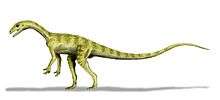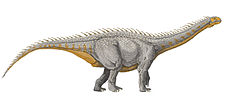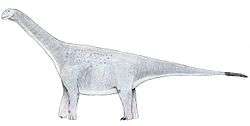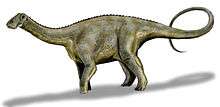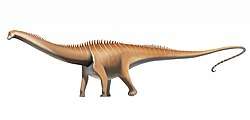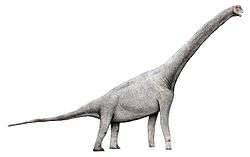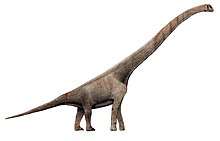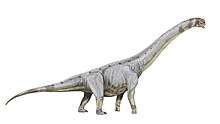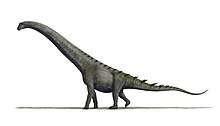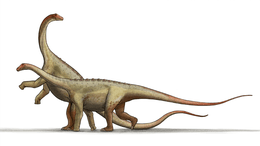Gyposaurus
Gyposaurus (meaning "vulture lizard", referring to the outdated hypothesis that prosauropods were carnivores) is a genus of basal sauropodomorph dinosaur from the early Jurassic of South Africa. It is usually considered to represent juveniles of other prosauropods, but "G." sinensis is regarded as a possibly valid species in recent reviews of the prosauropods (Galton and Upchurch, 2004).[1]
| Gyposaurus | |
|---|---|
 | |
| G. sinensis fossil on display at the Geological Museum of China | |
| Scientific classification | |
| Kingdom: | Animalia |
| Phylum: | Chordata |
| Clade: | Dinosauria |
| Clade: | Saurischia |
| Suborder: | †Sauropodomorpha |
| Clade: | †Plateosauria |
| Genus: | †Gyposaurus Broom, 1911 |
| Type species | |
| †Gyposaurus capensis (Broom, 1911) | |
| Other species | |
| |
Taxonomy

G. capensis was named in 1911 by Scottish physician and paleontologist Robert Broom from a partial skeleton consisting of eleven dorsal and six caudal vertebrae, ribs, gastralia, partial right scapula, right pelvic girdle, left ilium, and most of the right leg, discovered in the Upper Elliot Formation of Orange Free State, South Africa.[2] Originally, he thought it pertained to the dubious genus Hortalotarsus.[2] Galton and Cluver synonymized it with Anchisaurus in 1976,[3] but Michael Cooper synonymized it with Massospondylus in 1981,[4] which has been generally accepted.

G. sinensis was named by Yang Zhongjian (C.C. Young) in 1940 from most of a skeleton with a partial skull found in the Lower Jurassic Lufeng Formation, Yunnan Province, China, and referred over a dozen other specimens to it.[5] Galton in 1976 referred it to Lufengosaurus as a juvenile version,[6] but Dong Zhiming referred it to Anchisaurus in 1992.[7] As mentioned, in the most recent review, Galton and Upchurch (2004) consider it as probably a valid, distinct taxon, in need of a new generic name.[1] Unpublished results of a presentation by Wang and colleagues at the SVP 2017 conference indicate that G. sinensis is a junior synonym of Lufengosaurus huenei, however, while the referred specimens IVPP V43, V45, and V95 need further investigation.[8]
References
- Galton, P.M., and Upchurch, P. (2004). Prosauropoda. In: D. B. Weishampel, P. Dodson, & H. Osmólska (eds.), The Dinosauria (second edition). University of California Press:Berkeley, 232-258. ISBN 0-520-24209-2
- Broom, R. (1911). On the dinosaurs of the Stormberg, South Africa. Annals of the South African Museum 7(4):291-308.
- Galton, P.M., and Cluver, M.A. (1976). Anchisaurus capensis (Broom) and a revision of the Anchisauridae (Reptilia, Saurischia). Annals of the South African Museum 69(6):121-159.
- Cooper, M.R. (1981). The prosauropod dinosaur Massospondylus carinatus Owen from Zimbabwe: its biology, mode of life and phylogenetic significance. Occasional Papers of the National Museums and Monuments of Rhodesia, Series B, Natural Sciences 6(10):689-840.
- Z. Yang. 1940. Preliminary notes on the Lufeng vertebrate fossils. Bulletin of the Geological Society of China 20(3-4):235-239.
- Galton, P.M. (1976). Prosauropod dinosaurs (Reptilia: Saurischia) of North America. Postilla 169:1-98.
- Z. Dong. (1992). Dinosaurian Faunas of China. China Ocean Press:Beijing, 1-188. ISBN 0-387-52084-8
- http://vertpaleo.org/Annual-Meeting/Annual-Meeting-Home/SVP-2017-program-book-7-20-17a-(1).aspx
